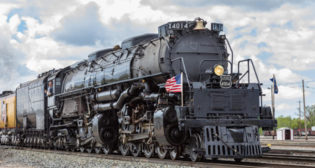
For Wabtec, ‘Positive Momentum’ Going Into 2021
Written by Marybeth Luczak, Executive Editor
Despite a challenging market, backlog remains strong, Wabtec Corp. reported during its fourth-quarter and full-year 2020 earnings release.
Wabtec also issued 2021 financial guidance.
Wabtec’s total, multi-year backlog at the end of December 2020 was $21.6 billion, which was higher than at Sept. 30 as OEM and after-market orders increased in both Freight and Transit, according to the company. At Dec. 31, 2020, the 12-month backlog was $5.5 billion, it noted.
In the fourth quarter, Wabtec said it had cash from operations of $326 million, sales of $2.0 billion, and GAAP earnings per diluted share of $0.46. Adjusted earnings per diluted share were $0.98; they excluded after-tax expenses of $0.20 for restructuring and transaction costs, $0.29 for non-cash amortization expense, and $0.03 for tax on transactions costs.
For the full year, the company said it had cash from operations of $784 million, including about $220 million in one-time cost impacts related to restructuring, transaction and litigation costs; sales of $7.6 billion; and GAAP earnings per diluted share of $2.17. Adjusted earnings per diluted share were $3.79; they excluded after-tax expenses of $0.45 for restructuring and transaction costs, $1.11 for non-cash amortization expense, $0.03 for foreign exchange loss, and $0.03 for tax on transaction costs.

“Wabtec delivered strong operational performance during a year of unprecedented global challenges,” Wabtec President and CEO Rafael Santana said. “We quickly protected our teams, kept our operations delivering for customers, and focused on liquidity, cost management, and execution to strengthen our financial position while returning significant capital to shareholders. We also never lost sight on future growth, investing in new sustainable rail technologies.
“We enter 2021 with positive momentum, as our end-markets continue to show signs of recovery. Global freight volumes and equipment utilization have sequentially improved over the last two quarters, North American OE markets are transitioning through trough, and sustainable investment in global transit remains. I’m confident we’re well-positioned for growth….”
Cowen and Company OEM Transportation Analyst Matt Elkott said Wabtec’s guidance was “a little light,” but “backlog grows.” He added: “Expect volatility.” (See “The Cowen Insight” section below.)
2021 Financial Guidance
• Wabtec issued its 2021 sales guidance to a range of $7.6 billion to $7.9 billion; GAAP earnings per diluted share guidance to between $2.65 to $3.05; and adjusted earnings per diluted share to between $3.90 to $4.30. The adjusted guidance excludes estimated expenses for restructuring and amortization expenses, the company noted.
• “With cost actions and synergies stemming from the Wabtec and GE Transportation merger on track, we expect to achieve a run rate savings of $250 million in 2021, driving improved margins,” Wabtec reported. “For full year 2021, Wabtec expects strong cash flow generation with operating cash flow conversion of greater than 90%.”
• The company said it renewed its share buyback authorization up to $500 million.
Fourth-quarter 2020 Highlights
Consolidated Results:
• Sales were $2.0 billion, down 16.7% compared with $2.4 billion in the same period a year earlier. This was “primarily driven by lower sales in Freight Equipment, Components, Digital Electronics, and Transit Aftermarket sales,” Wabtec reported.
• Income from operations was $161 million (8% of sales) and adjusted income from operations was $283 million (14% of sales). This was “unfavorably impacted by lower sales in Freight and Transit primarily due to COVID-19 pandemic disruptions,” the company said. Adjusted income from operations excluded pre-tax expenses of $122 million, of which $71 million is for non-cash amortization expense and $51 million is for restructuring and transaction costs, according to Wabtec.
• Net interest expense was $49 million and other income was $6 million.
• The reported and adjusted effective tax rates for the quarter were 26.6% and 22.6%, respectively.
• EBITDA was $285 million. Adjusted EBITDA was $337 million and excluded pre-tax expenses of $51 million for transaction and restructuring costs.
Freight Segment Results:
• Sales of $1.3 billion fell 20% from the year-ago quarter, “due to lower organic sales of $327 million and unfavorable changes in foreign currency exchange rates of $11 million, offset somewhat by $10 million of sales from acquisitions,” Wabtec reported. “Freight segment sales were primarily impacted by disruption due to the COVID-19 pandemic resulting from lower deliveries of locomotives, lower demand for new freight car components, and lower Digital Electronics sales.”
• Income from operations was $121 million (9% of segment sales) and adjusted income from operations was $218 million (16.3% of segment sales). Freight segment adjusted income from operations declined 31% from the year-ago quarter “primarily driven by mix of sales, lower absorption of fixed costs due to decreased locomotive deliveries, offset somewhat by synergies and lower operating costs,” the company said. “During the quarter, we took further actions to aggressively adjust operational costs to current volume levels.”
Transit Segment Results:
• Sales of $684 million decreased by 2% from the same quarter a year earlier, “due to lower organic sales of $54 million, offset somewhat by favorable changes in foreign currency exchange rates of $37 million,” Wabtec reported. “Transit segment sales were negatively impacted by lower after-market sales primarily related to the disruption caused by the COVID-19 pandemic.”
• Income from operations was $57 million (8.3% of segment sales) and adjusted income from operations was $77 million (11.3% of segment sales). According to Wabtec, adjusted income from operations increased 40% from the year-ago quarter “as a result of continued improvement in operational performance, improved risk management and cost actions, offset somewhat by lower volumes as a result of the COVID-19 pandemic.”
The Wabtec website provides more details.
The Cowen Insight

“EPS represented a 5% miss and operating income was a 2% miss to consensus,” said Cowen and Company transportation equipment analyst Matt Elkott. “2021 EPS guidance of $3.90-$4.30 was a little light compared to consensus of $4.34. However, both the total and 12-month backlogs increased since September 30, including a strong increase in the transit backlog.”
Among the key takeaways:
• “EPS of $0.98 was 5% below our and the consensus estimate of $1.03. Operating income came in at $283MM, compared to consensus of $288MM and our $302MM estimate. Revenue was $2.02Bn, compared to consensus of $2.03Bn and our $2.01Bn forecast.
• “The total backlog of $21.6Bn was up from $21.4Bn in September. This reflected increases in both the freight and transit backlogs. The 12-month backlog also increased to $5.5Bn, from $5.2Bn, as a strong 24% increase in transit more than offset a 1% decrease in freight. The increase in the total and 12-month transit backlog should help alleviate some pandemic related concerns about the segment. We have long thought that such concerns were overblown.” (See Elkott’s “Election ‘Blues’ Could Benefit Rail Suppliers” column.)
• “The company increased its share repurchase program to $500MM.

• “We would not be surprised to see some rail service hiccups created by a confluence of factors: higher volumes, winter weather disruptions, and the fact that 2021 should be the first year ever to see traffic growth at the same time that substantially all railroads are implementing some iteration of PSR. Such disruptions could have a positive effect on WAB’s aftermarket business, including DC-to-AC locomotive models and other equipment upgrades given limited built-in redundancies in the rail network currently.
• “The North American railcar industry fleet utilization has posted yet another sequential improvement, with units in storage declining to 397K in February, from 409K in January. Since July, idled railcars have dropped by ~129K units as a result of favorable rail traffic trends (Class I volumes up 6% QTD, following a 3% increase in 4Q20, which ended nearly two years of mostly declining traffic). We expect rail traffic to increase in the mid-single digits this year. Additionally, scrap prices have warranted a higher degree of equipment retirements, and the PSR headwinds to railcar demand are already largely reflected in the current operating network.”



